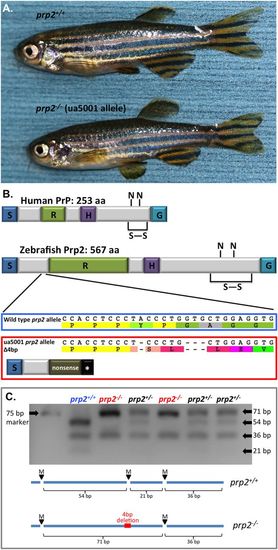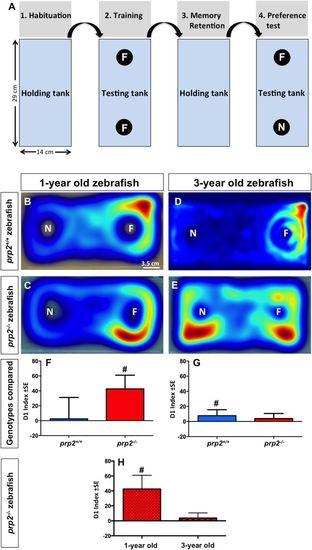- Title
-
An ancient conserved role for prion protein in learning and memory
- Authors
- Leighton, P.L.A., Nadolski, N.J., Morrill, A., Hamilton, T.J., Allison, W.T.
- Source
- Full text @ Biol. Open
|
Prion mutant prp2−/− zebrafish develop normally and display no overt phenotypes during adulthood. (A) A young adult (∼1-year-old) prp2+/+ fish is pictured on top, while a young adult prp2−/− fish is pictured on the bottom. (B) Zebrafish Prp2 is conserved with mammalian PrPC at the protein domain level. Both have a signal peptide (S), a repeat region (R; though the repetitive region in zebrafish is longer and less patterned than the octarepeats in mammals), a hydrophobic domain (H) and are attached to the cell surface by a GPI anchor (G). Like mammalian PrPC, zebrafish Prp2 also has putative N-linked glycosylation sites (N) and a disulphide bond (S–S) within its C-terminus. The zebrafish prp2 ua5001 allele has a 4 base pair deletion (frameshift), which produces an early stop codon and a putative nonsense protein lacking all these conserved domains. Further, the prp2 gene product is greatly reduced in abundance, in prp2−/− mutant zebrafish, including in the brain tissue of adult fish (Fleisch et al., 2013). (C) Restriction fragment length polymorphism (RFLP) assay used for genotyping zebrafish at the prp2 gene locus. There is an Mva cut site in the wild-type prp2 sequence that is not present in the mutant (ua5001 allele) prp2 sequence, leading to a smaller band when the PCR product from prp2+/+ zebrafish is digested (54 bp) compared to from prp2−/− zebrafish (71 bp). bp, base pair. |
|
Zebrafish lacking prion protein exhibited minor reductions in memory in an age-dependent fashion. Prp2−/− fish showed a trend towards an age-dependent decline in familiar object preference with the object preference test. (A) Flowchart summarizing the sequence of events in the object preference test. (1) Fish were first habituated to a tank of the same size as the testing arena (the holding tank). (2) Fish were then netted and moved to the testing tank containing two identical objects (F) for the 10-min training phase. (3) Fish were then moved back to the holding tank for a 1- or 5-min period (memory retention interval), during which time one of the familiar objects (F) in the testing tank was replaced with a novel object (N). (4) Finally, fish were placed back into the testing tank for the 10-min object preference test. (B,C) Sample heat maps of 1-year-old prp2+/+ fish and prp2−/− fish that displayed object preference during the test phase. Top down view of the test tank, wherein fish can swim around the novel object (N) and/or the familiar object (F). Warm colours (yellows and reds) in the heat map indicate this individual fish spent more time near the familiar object, which was interpreted herein as indicating the fish remembered this object from its earlier training phase (see Materials and Methods and assumptions in Discussion). Scale bar: 3.5 cm (the approximate size of an adult zebrafish). (D,E) Sample heat maps of 3-year-old prp2+/+ fish and prp2−/− fish. This representative prp2+/+ fish (D) exhibited familiar object preference during the test phase, while this example prp2−/− fish (E) did not (quantified across multiple replicates below). (F) 1-year-old prp2−/− zebrafish displayed familiar object preference following a 1-min retention interval, while the 1-year-old prp2+/+ fish did not, as revealed by the D1 index of object preference (# indicates significant difference from 0 at P<0.05 using the Wilcoxon Signed Rank test; n=13 prp2+/+ fish, n=28 prp2−/− fish). (G) 3-year-old prp2+/+ fish displayed familiar object preference after a 1-min retention interval while 3-year old prp2−/− fish did not (D1 discrimination index, # indicates significant difference from 0 at P<0.05 using the Wilcoxon signed rank test; n=16 fish/genotype). (H) Zebrafish lacking prion protein (prp2−/−) displayed a notable, though not statistically significant, reduction in familiar object preference when comparing between ages as measured by D1 (values replotted from Fig. 2F,G). PHENOTYPE:
|

ZFIN is incorporating published figure images and captions as part of an ongoing project. Figures from some publications have not yet been curated, or are not available for display because of copyright restrictions. PHENOTYPE:
|

ZFIN is incorporating published figure images and captions as part of an ongoing project. Figures from some publications have not yet been curated, or are not available for display because of copyright restrictions. PHENOTYPE:
|

ZFIN is incorporating published figure images and captions as part of an ongoing project. Figures from some publications have not yet been curated, or are not available for display because of copyright restrictions. PHENOTYPE:
|


